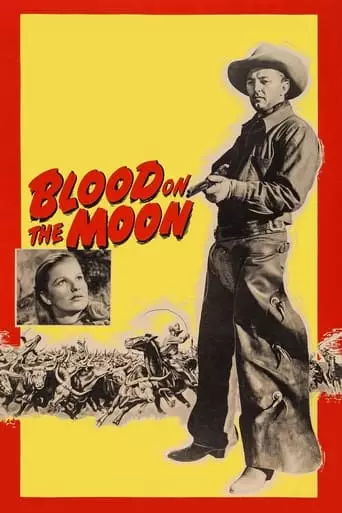
Blood on the Moon (1948) Watch Online Free
Down-and-out cowhand Jim Garry is asked by his old friend Tate Riling to help mediate a cattle dispute. When Garry arrives, however, it soon becomes clear that Riling has not been entirely forthright. Garry uncovers Riling’s plot to dupe local rancher John Lufton out of a fortune. When Lufton’s firecracker of a daughter, Amy, gets involved, Garry must choose between his old loyalties and what he knows to be right.
Blood on the Moon (1948) is a psychological Western film noir that follows the story of Jim Garry, portrayed by Robert Mitchum, a drifter who becomes embroiled in a conflict between cattle ranchers and homesteaders. The film begins with Garry being summoned by his old acquaintance, Tate Riling (Robert Preston), who has sinister plans to force rancher John Lufton (Walter Brennan) into selling his cattle at a fraction of their worth. Upon arriving at the Indian reservation, Garry learns that Riling and his accomplice, Indian agent Jake Pindalest (Frank Faylen), are orchestrating a scheme to manipulate the homesteaders into blocking Lufton’s cattle from being moved off the reservation. Riling’s deceitful tactics involve convincing the homesteaders that he is working in their best interest while actually aiming to benefit from Lufton’s misfortune. As Garry interacts with the Lufton family, particularly daughters Amy (Barbara Bel Geddes) and Carol (Phyllis Thaxter), he finds himself torn between loyalty to Riling and his growing affection for Amy. The tension escalates when Riling’s plan leads to tragedy, including the death of a young man during a stampede orchestrated by Riling’s gang. Disillusioned by Riling’s ruthless methods, Garry decides to take a stand against him. The climax of the film features intense confrontations as Garry, with the help of Amy and rancher Kris Barden (who has lost his son), fights back against Riling and his henchmen. After a series of violent encounters, Garry manages to defeat Riling, leading to a resolution where he and Amy can finally envision a future together.
Redemption and Morality
At its core, Blood on the Moon explores themes of redemption and moral complexity. Jim Garry embodies the archetype of the flawed hero—a drifter with a troubled past who seeks redemption through love and action. His journey reflects an internal struggle between right and wrong, as he grapples with his conscience while navigating a world rife with corruption. The stark contrast between Garry’s moral compass and Riling’s unscrupulous nature underscores the film’s exploration of ethical dilemmas in a lawless environment. Deception and Betrayal
The film also delves into themes of deception and betrayal. Riling represents manipulative power, using charm to disguise his malevolent intentions. His relationship with Carol Lufton further complicates matters, as he exploits her affections for personal gain while betraying her family. This theme resonates throughout the narrative, illustrating how personal relationships can become entangled in broader conflicts, leading to tragic consequences. Conflict Between Settlers and Ranchers
The backdrop of conflict between homesteaders and cattle ranchers serves as a metaphor for larger societal struggles. The film reflects post-war anxieties about land ownership, community rights, and individualism versus collectivism. The portrayal of characters like Lufton and Barden highlights the struggles faced by those defending their livelihoods against external threats.
Blood on the Moon has left a lasting impact on the Western genre by blending elements of film noir with traditional Western motifs. Directed by Robert Wise, known for his ability to create tension and atmosphere, the film stands out for its psychological depth and moral ambiguity. It paved the way for future Westerns that sought to explore complex character dynamics rather than relying solely on action-driven plots. The film’s cinematography employs shadows and darkness effectively, enhancing its noir aesthetic while creating an ominous tone that permeates the narrative. This stylistic choice influenced subsequent films within both genres, demonstrating how visual storytelling can enhance thematic exploration.
After watching Blood on the Moon, viewers may experience a profound sense of reflection regarding moral choices and human relationships. The film’s exploration of redemption invites contemplation about one’s own life decisions—prompting questions about integrity in challenging circumstances. You might feel emotionally invested in Jim Garry’s journey; his struggles resonate deeply with those seeking purpose or grappling with their pasts. The resolution offers hope through love yet leaves lingering thoughts about sacrifices made along the way—a bittersweet reminder that redemption often comes at great cost. Ultimately, Blood on the Moon may evoke feelings ranging from excitement due to its thrilling plot twists to introspection stemming from its complex themes—making it an unforgettable cinematic experience that lingers long after viewing ends.
